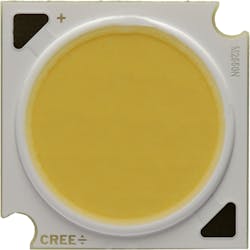The XLamp CMA chip-on-board LED family delivers more than double the lumen density of Cree’s existing Standard Density COB LEDs yet provide a lower-cost option to the company’s High Density products.
Cree has announced the XLamp CMA family of chip-on-board (COB) LEDs that mark the company’s first foray into such LEDs manufactured on an aluminum substrate as opposed to a ceramic substrate. Cree is informally calling the new line a high-current family and positioning the portfolio to fit between the Standard Density and High Density ceramic-based LEDs announced previously.
Interested in articles & announcements on COB LEDs?
The type of substrate used in COB LEDs has not been a mainstream issue, although LED makers and some solid-state lighting (SSL) product developers have strong feelings on the topic. Indeed, some lighting manufacturers will only buy one or the other type of COBs, and most LED manufacturers have chosen one path or the other. Cree may be the only mainstream LED manufacturer with both types of COBs in its product line.
Ceramic substrates for COB LEDs generally deliver better thermal performance. The rear surface of a ceramic COB LED is perfectly flat and mates well with other materials and the devices don’t thermally expand. But ceramic-based COB LEDs are brittle. Generally, the devices must be mounted in a luminaire design using a mechanical holder of some sort.
Cree’s newest COB LEDs fill the void for an aluminum-substrate-based COB in the company’s product line.
Metal or aluminum substrates are not perfectly flat. But the finished LEDs are not brittle and can be attached with screws in a luminaire design. The metal, however, can expand with heat so thermal mitigation must be handled with care if the devices are affixed with screws. In general, there are reliable and high-performing COBs from both camps being manufactured and used in lighting products.
For Cree, the CMA line may serve two goals. They now have a product to offer development teams that are insistent on using COB LEDs with metal substrates. And the new family fills a void between two existing product lines.
Cree launched its second-generation High Density CXA family back in March of 2016. That CXA2 family was said to offer a 40% performance improvement over the first-generation High Density family launched in 2013. Cree had launched second-generation Standard Density COBs in February of 2015.
In terms of fit for the product developer, the CMA family will primarily be valuable as a way to move up from Standard Density products without paying the full price for High Density COB LEDs. The new line covers five light-emitting surface (LES) diameters — 9, 12, 14, 19, and 23 mm. The 12-mm CMA 1825, for instance, delivers a range of 2150–7300 lm depending on drive current, CCT, and CRI. Cree said that in general the performance numbers in terms of efficacy are on the order of 10% higher than second-generation Standard Density (CXB family) LEDs, although the company also said that lumen density can be more than twice what the Standard Density products deliver.
Product developers might leverage the performance advantage in two ways. Teams could convert an existing design to use an LED with a 40% smaller LES and derive the same lumen output. Or teams can upgrade the lumen output in the same LES footprint.
Cree did say the CMA family can use the same optics, holders, drivers, and other components that have been used with the CXA and CXB families. But there will be no shortcut in terms of LM-80 testing based on an evolutionary upgrade of an existing LED, because the CMA is an all-new design for Cree. Full LM-80 data won’t be available until early next year, although that timing may work fine for typical product design cycles.
Still, consistency in mechanics is important. “Cree is an outstanding partner for LED lighting because of their customer-focused innovation,” said Andrea Gallucci, head of optics & electronics at Artemide. “Since the new High Current CMA LED Arrays are compatible with the Standard Density CXA2 LED family, we can easily deliver more visual impact while maintaining the same optics options and color quality choices that our customers are looking for. These new CMA LEDs will speed up the pace of performance enhancements within both our iconic and innovative luminaire designs.”
The CMA LEDs are available across the 2700K–6500K CCT range and at 70, 80, and 90 CRI. Cree will also offer the CMA COB LEDs in what it calls Premium Color options with up to 98 CRI and custom chromaticity points. The company rolled out the Premium Color technology with chromaticities off the black-body locus when it announced the second-generation High Density line last year.

Maury Wright | Editor in Chief
Maury Wright is an electronics engineer turned technology journalist, who has focused specifically on the LED & Lighting industry for the past decade. Wright first wrote for LEDs Magazine as a contractor in 2010, and took over as Editor-in-Chief in 2012. He has broad experience in technology areas ranging from microprocessors to digital media to wireless networks that he gained over 30 years in the trade press. Wright has experience running global editorial operations, such as during his tenure as worldwide editorial director of EDN Magazine, and has been instrumental in launching publication websites going back to the earliest days of the Internet. Wright has won numerous industry awards, including multiple ASBPE national awards for B2B journalism excellence, and has received finalist recognition for LEDs Magazine in the FOLIO Eddie Awards. He received a BS in electrical engineering from Auburn University.





